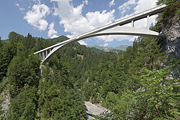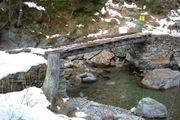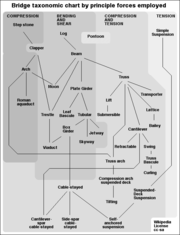Bridge
2008/9 Schools Wikipedia Selection. Related subjects: Engineering
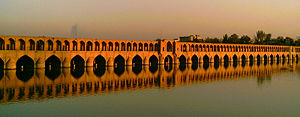
A bridge is a structure built to span a gorge, valley, road, railroad track, river, body of water, or any other physical obstacle, for the purpose of providing passage over the obstacle. Designs of bridges will vary depending on the function of the bridge and the nature of the terrain where the bridge is to be constructed.
History
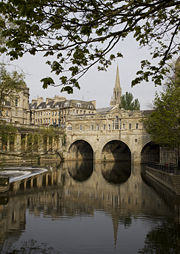
The first bridges were made by nature — as simple as a log fallen across a stream. The first bridges made by humans were probably spans of wooden logs or planks and eventually stones, using a simple support and crossbeam arrangement. Most of these early bridges could not support heavy weights or withstand strong currents. It was these inadequacies which led to the development of better bridges.
Epic literature of India provides mythological accounts of bridges constructed from India to Lanka by the army of Rama. The Arthashastra of Kautilya mentions the construction of dams and bridges. A Mauryan bridge near Girnar was surveyed by James Princep. The bridge was swept away during a flood, and later repaired by Puspagupta, the chief architect of emperor Chandragupta I. The bridge also fell under the care of the Yavana Tushaspa, and the Satrap Rudra Daman. The use of stronger bridges using plaited bamboo and iron chain was visible in India by about the 4th century. A number of bridges, both for military and commercial purposes, were constructed by the Mughal administration in India.
The ancient Romans built arch bridges and aqueducts that could stand in conditions that would damage or destroy earlier designs. Some of them still stand today. An example is the Alcántara Bridge, built over the river Tagus, in Spain. Most earlier bridges would have been swept away by the strong current. The Romans also used cement, which reduced the variation of strength found in natural stone. One type of cement, called pozzolana, consisted of water, lime, sand, and volcanic rock. Brick and mortar bridges were built after the Roman era, as the technology for cement was lost then later rediscovered.
Although large Chinese bridges of wooden construction existed at the time of the Warring States, the oldest surviving stone bridge in China is the Zhaozhou Bridge, built from 595 to 605 AD during the Sui Dynasty. This bridge is also historically significant as it is the world's oldest open- spandrel stone segmental arch bridge. European segmental arch bridges date back to at least the Alconétar Bridge (approximately 2nd century AD), while the enormous Roman era Trajan's Bridge (105 AD) featured open-spandrel segmental arches in wooden construction.
Rope bridges, a simple type of suspension bridge, were used by the Inca civilization in the Andes mountains of South America, just prior to European colonization in the 1500s.
During the 18th century there were many innovations in the design of timber bridges by Hans Ulrich, Johannes Grubenmann, and others. The first book on bridge engineering was written by Hubert Gautier in 1716.
With the Industrial Revolution in the 19th century, truss systems of wrought iron were developed for larger bridges, but iron did not have the tensile strength to support large loads. With the advent of steel, which has a high tensile strength, much larger bridges were built, many using the ideas of Gustave Eiffel.
Etymology
The Oxford English Dictionary traces the origin of the word bridge to an Old English word brycg, of the same meaning, derived from a hypothetical Proto-Germanic root brugjō. There are cognates in other Germanic languages (for instance Brücke in German, brug in Dutch, brúgv in Faroese or bro in Danish, Norwegian and Swedish).
Another theory suggests that "bridge" comes from Turkish "köprü" (lit. bridge). It is highly possible that Turkish lent this word to Eastern European languages and then, in time, it arrived in English. "Köprü" itself is derived from "köprük (köpük)" which literally means "foam".
The word for the Pope, pontiff, comes from the Latin word pontifex meaning "bridge builder" or simply "builder". The word "Pope" however comes from "papa" meaning "father".
Types of bridges
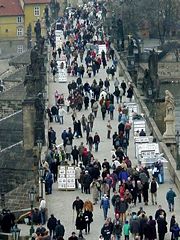
There are six main types of bridges: beam bridges, cantilever bridges, arch bridges, suspension bridges, cable-stayed bridges and truss bridges.
Beam bridges
Beam bridges are horizontal beams supported at each end by piers. The earliest beam bridges were simple logs that sat across streams and similar simple structures. In modern times, beam bridges are large box steel girder bridges. Weight on top of the beam pushes straight down on the piers at either end of the bridge.
Cantilever bridges
Cantilever bridges are built using cantilevers — horizontal beams that are supported on only one end. Most cantilever bridges use two cantilever arms extending from opposite sides of the obstacle to be crossed, meeting at the centre. The largest cantilever bridge is the 549 feet (167 m) Quebec Bridge in Quebec, Canada.
Arch bridges
Arch bridges are arch-shaped and have abutments at each end. The earliest known arch bridges were built by the Greeks and include the Arkadiko Bridge. The weight of the bridge is thrusted into the abutments at either side. Dubai in the United Arab Emirates is currently building the largest arch bridge in the world, which is scheduled for completion in 2012.
Suspension bridges
Suspension bridges are suspended from cables. The earliest suspension bridges were made of ropes or vines covered with pieces of bamboo. In modern bridges, the cables hang from towers that are attached to caissons or cofferdams. The caissons or cofferdams are implanted deep into the floor of a lake or river. The longest suspension bridge in the world is the 12,826 feet (3,909 m) Akashi Kaikyo Bridge in Japan.
Cable-stayed bridges
Like suspension bridges, cable-stayed bridges are held up by cables. However, in a cable-stayed bridge, less cable is required and the towers holding the cables are proportionately shorter. The first known cable-stayed bridge was designed in 1784 by C.T. Loescher. The longest cable-stayed bridge is the Tatara Bridge in the Seto Inland Sea, Japan.
Truss bridges
Truss bridges are composed of connected elements. They have a solid deck and a lattice of pin-jointed girders for the sides. Early truss bridges were made of wood, but modern truss bridges are made of metals such as wrought iron and steel. The Quebec Bridge, mentioned above as a cantilever bridge, is also the world's longest truss bridge.
By use
A bridge is designed for trains, pedestrian or road traffic, a pipeline or waterway for water transport or barge traffic. An aqueduct is a bridge that carries water, resembling a viaduct, which is a bridge that connects points of equal height. A road-rail bridge carries both road and rail traffic.
Bridges are subject to unplanned uses as well. The areas underneath some bridges have become makeshift shelters and homes to homeless people, and the undersides of bridges all around the world are spots of prevalent graffiti. Some bridges attract people attempting suicide, and become known as suicide bridges.
Decorative or ceremonial
To create a beautiful image, some bridges are built much taller than necessary. This type, often found in east-Asian style gardens, is called a Moon bridge, evoking a rising full moon. Other garden bridges may cross only a dry bed of stream washed pebbles, intended only to convey an impression of a stream. Often in palaces a bridge will be built over an artificial waterway as symbolic of a passage to an important place or state of mind. A set of five bridges cross a sinuous waterway in an important courtyard of the Forbidden City in Beijing, the People's Republic of China. The central bridge was reserved exclusively for the use of the Emperor, Empress, and their attendants.
The differences & similarities in bridge structure
Bridges may be classified by how the forces of tension, compression, bending, torsion and shear are distributed through their structure. Most bridges will employ all of the principal forces to some degree, but only a few will predominate. The separation of forces may be quite clear. In a suspension or cable-stayed span, the elements in tension are distinct in shape and placement. In other cases the forces may be distributed among a large number of members, as in a truss, or not clearly discernible to a casual observer as in a box beam. Bridges can also be classified by their lineage, which is shown as the vertical axis on the diagram to the right.
Efficiency
A bridge's structural efficiency may be considered to be the ratio of load carried to bridge mass, given a specific set of material types. In one common challenge students are divided into groups and given a quantity of wood sticks, a distance to span, and glue, and then asked to construct a bridge that will be tested to destruction by the progressive addition of load at the centre of the span. The bridge taking the greatest load is by this test the most structurally efficient. A more refined measure for this exercise is to weigh the completed bridge rather than measure against a fixed quantity of materials provided and determine the multiple of this weight that the bridge can carry, a test that emphasizes economy of materials and efficient glue joints (see balsa wood bridge).
A bridge's economic efficiency will be site and traffic dependent, the ratio of savings by having a bridge (instead of, for example, a ferry, or a longer road route) compared to its cost. The lifetime cost is composed of materials, labor, machinery, engineering, cost of money, insurance, maintenance, refurbishment, and ultimately, demolition and associated disposal, recycling, and replacement, less the value of scrap and reuse of components. Bridges employing only compression are relatively inefficient structurally, but may be highly cost efficient where suitable materials are available near the site and the cost of labor is low. For medium spans, trusses or box beams are usually most economical, while in some cases, the appearance of the bridge may be more important than its cost efficiency. The longest spans usually require suspension bridges.
Double-decker bridge
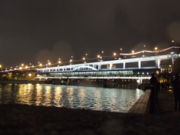
Double-decker bridges have two levels, such as the San Francisco-Oakland Bay Bridge, with two road levels. Tsing Ma Bridge and Kap Shui Mun Bridge in Hong Kong have six lanes on their upper decks, and on their lower decks there are two lanes and a pair of tracks for MTR metro trains. Some double-decker bridges only use one level for street traffic; the Washington Avenue Bridge in Minneapolis reserves its lower level for automobile traffic and its upper level for pedestrian and bicycle traffic (predominantly students at the University of Minnesota).
Robert Stephenson's High Level Bridge across the River Tyne in Newcastle upon Tyne, completed in 1849, is an early example of a double-deck bridge. The upper level carries a railway, and the lower level is used for road traffic.
Another example is Craigavon Bridge in Derry, Northern Ireland. The Oresund Bridge between Copenhagen and Malmö consists of a four-lane highway on the upper level and a pair of railway tracks at the lower level.
The George Washington Bridge between New Jersey and New York has two roadway levels. It was built with only the upper roadway as traffic demands did not require more capacity. A truss work between the roadway levels provides stiffness to the roadways and reduced movement of the upper level when installed.
Tower Bridge is different example of a double-decker bridge, with the central section consisting of a low level bascule span and a high level footbridge.
More than just a bridge

- Some bridges carry special installations such as the tower of Nový Most bridge in Bratislava which carries a restaurant. Other suspension bridge towers carry transmission antennas.
- A bridge can carry overhead power lines as does the Storstrøm Bridge.
- Costs and cost overruns in bridge construction have been studied by Flyvbjerg et al. (2003). The average cost overrun in building a bridge was found to be 34%.
Visual index
Index to types
Index to related topics
Politics
Most bridges are built for economic reasons, meaning they are cost justified. As the size and cost go up it becomes more difficult to cost justify bridges. Some of the largest and most costly bridges in the world are built for political reasons, namely to tie together otherwise isolated areas.

